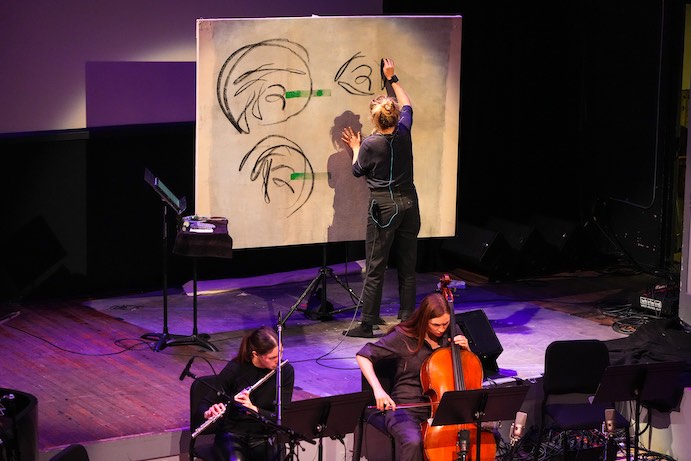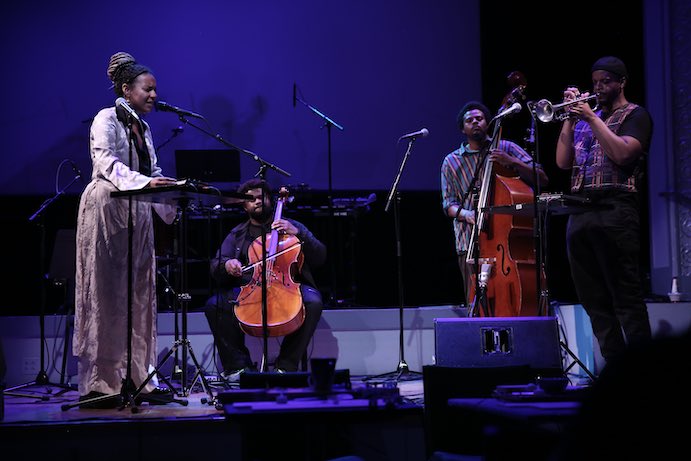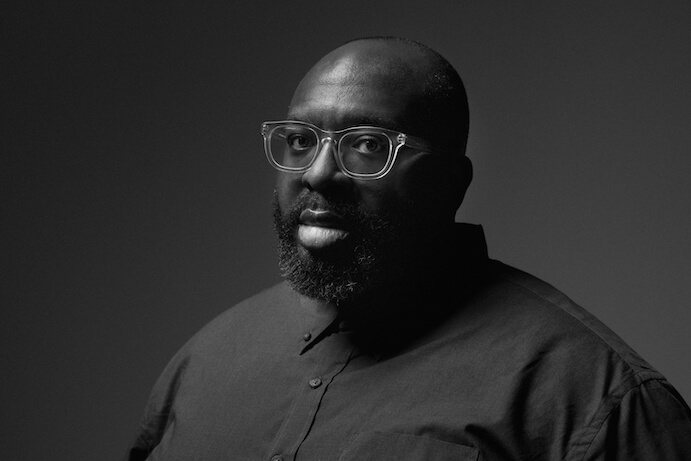When spring arrives in New York City, so does the MATA festival. Each year, Music at the Anthology (MATA) places a free global call for submissions and presents emerging composers and multimedia artists working in a super-wide aesthetic range. But the 2022 festival, which took place May 4-7 at the Brooklyn venues Roulette Intermedium and National Sawdust, inaugurated a new era for MATA. It was the first live festival since 2019, it was the first live festival with Executive Director Amanda Gookin at the helm, and it was the first festival with an Artist-in-Residence. Usually unified only by experimental efforts and occasionally wacky sounds, composer and saxophonist Darius Jones pulled the threads of the festival together by curating three programs and composing a fourth headlining event of his own.
MATA 2022 opened with Doyenne Diaries by Michele Cheng, a playful piece originally conceived for solo performer and expanded here to a quartet. In this improvised electroacoustic work, each performer (Cheng, Pala Garcia, Tamika Gorski, Clara Warnaar) sat at a small table with a self-built wooden board instrument and a collection of found objects and small toys. The board amplified and recorded contact sounds such as falling beans and scraped tuning forks. The performers then looped, modified, and loosely coordinated the sounds with a recording of four women describing their daily activities. It was entertaining to watch the performers play with the boards, which added a built-art element to the piece, and the recorded memories underscored the value of simple daily life.
Also featuring a self-built instrument was June Young (Will) Kim’s piece Black, Emerald for amplified canvas and instrumental ensemble. Kim placed four contact microphones behind a large canvas, and a performer wearing a wrist motion sensor followed strict score instructions to create a series of curved charcoal lines and thick emerald brushstrokes. Kim then used software to modify the contact sounds on the canvas based on the speed of the artist’s gesture and blended it with the ensemble’s atmospheric muzak.

The standout piece harnessing technology was Jess Rowland’s Music for Cell Phone and Piano. The composition changes depending on the interior design of each piano and the lit environment; for this rendition Rowland was able to work with Roulette’s lighting designer Alejandro Fajardo to bathe the piano in a rainbow wash of hues. Pianist Blair McMillen then placed a cell phone inside the piano, and as the piece progressed, the projected video dove further inside the instrument, creating abstract images that showed string vibrations and occasional light flares. With a deep intuition for beauty, Rowland transformed the grand piano’s familiar bulk into an intimate sound visualizer and animated sculpture.
While many of the works utilized electronics, there were also several noteworthy purely acoustic works. (The International Contemporary Ensemble were the primary acoustic performers during the festival.) Mengmeng Wang’s The Sounds I Can Hear When I Miss You for prepared solo violin was sparse and full of silence, a genuine sonic translation of longing and separation. Naftali Schindler’s Chants, Pastorals, and Antiphons of the New Moon for harp and horn contrasted musical simplicity with a decadent instrumental pairing; the resonance of the two instruments was a reminder of what makes live performance so special. Francisco del Pino’s Un Pez Dorado used the uniform timbre of a clarinet quartet to perfection, creating gentle polyphonies and using dissonant sound beats to build complex rhythms. It was lucid, entrancing music perfect for the intimate National Sawdust venue.
In addition to abstract works, there were several topical pieces that directly addressed social justice. Chris Ryan Williams’ structured improvisation Of Yours for voice (Shara Lunon), trumpet (Williams), cello (Lester St. Louis), and bass (Luke Stewart) was both an appropriately loud indictment of white supremacy — “They don’t know their God … much in the American pie is not worth eating” — and a jubilant sonic determination to persevere. Nina Fukuoka’s Sugar, Spice, & All Things Nice told the anonymous stories of women who have experienced sexual harassment in classical music. Shara Lunon’s exceptional Samples No. 3: Why I Believe Womyn presented excerpts from various women’s writings or court testimonies before the voice and bassoon duo improvised an emotional response. Fay Victor’s vocal and stylistic dexterity were astounding, and Rebekah Heller gave a trademark performance of passion and sensitivity.

The strength of these sonic justice works made it all the more jarring to experience what turned out to be the festival’s biggest flop. During the first two nights, MATA tried to ease the formality of a standard concert setting and fill time between lengthy technological transitions by hiring a comedian as emcee. This well-intentioned gesture was ultimately unnecessary; the events at Roulette already had a casual, easygoing atmosphere, and the audience members felt free to chat or visit the bar between pieces. Worse, the comedian seemed not to have been briefed on the content of the program: following both of the pieces about sexual assault, he had to awkwardly segue into comedic bits while admitting that he had no idea those topics were part of the evening. He struggled to articulate responses to the pieces, and his deadpan irony was poorly matched to the energetic mood of the event. In the future, it seems important to select a host who is somewhat familiar with the music and aware of sensitive topics on the program.
The programming was generally well-balanced and interesting, but there were also some musical misfires. In Christian Dimpker’s N. 11 (String Quartet 1), the performers bowed the wooden edges of their instruments so slowly that barely any sound emerged; they eked out thin high pitches or slowly smashed their bows against strings between periods of silence. Dimpker is a theorist working to create a consistent notational system for extended instrumental playing and electroacoustic music techniques, and it’s easy to see the interest of his work for practitioners. But without efforts to share this value with the audience, the piece seemed to merely indulge the composers. Likewise in John Aulich’s Green, or Beautiful in Green, an extended section sounded like bodily functions despite the program notes describing a sacred Ancient Egyptian inspiration. A general audience, facing unfamiliar sounds with only disjunct program notes, would benefit from seeing the visual aspects of such scores to at least appreciate notational invention. Otherwise, it seems like we are asking people to merely applaud shock value.

Darius Jones’ spectacular headline concert was a masterful example of how to challenge an audience with empathy and innovation. Even in a festival full of blurred boundaries and wild aesthetic variance, his work Colored School No. 3 (Extra Credit) defied categories: a performance art piece for actor/voice, string quartet, and jazz trio that schools its audience with fierce compassion. He wrote in his program notes:
“As the years go by, what took place or existed on a piece of land fades from the memory of the majority, unless society deems it important. … Musical genres or styles can contain periods of time within them transporting us back to a place or creating a state of nostalgia. But when we let go of style and genre, give in to sound and experimentation, and investigate historical matters, we embark on an abstract voyage.”
Colored School No. 3 contextualized itself in America and historical racism before veering kindly but firmly into the present. Aviva Jaye, leading the piece with exceptional gravitas, presented prismatic retellings of the lives of Breonna Taylor, Elijah McClain, Ketanji Brown Jackson, and herself. The jazz trio grounded each section with slow, pulsating rhythms and haunting saxophone hooks that gave the listening “classroom” time to transition from lesson to lesson. Meanwhile, the string quartet revealed inner worlds with delicate traditional figures and exploding external danger into the scene with aggressive extended techniques. Jaye was twice brought to tears by the power and grief of the visceral stories. By the end of the piece, a diverse but collective cloud of Black witness had emerged from American brutality with the will to hope and beautify life.
Nearly all the works presented were from a U.S.-based composer, which was a disappointment compared to previous years. But Jones’ final composition, a deeply American piece, still crystallized the best of what the MATA can continue to be: an environment that supports its collaborators, welcomes its audience to participate, and makes it possible to take risks.
I CARE IF YOU LISTEN is an editorially-independent program of the American Composers Forum, funded with generous donor and institutional support. Opinions expressed are solely those of the author and may not represent the views of ICIYL or ACF.
A gift to ACF helps support the work of ICIYL. For more on ACF, visit the “At ACF” section or composersforum.org.
























